Art World
Here’s What a 60-Mile Bike Ride to Edward Hopper’s Childhood Home Taught Me About His Art
To celebrate Edward Hopper’s 142nd birthday, the Whitney Museum of American Art hosted its second annual bike ride to the artist's birthplace.
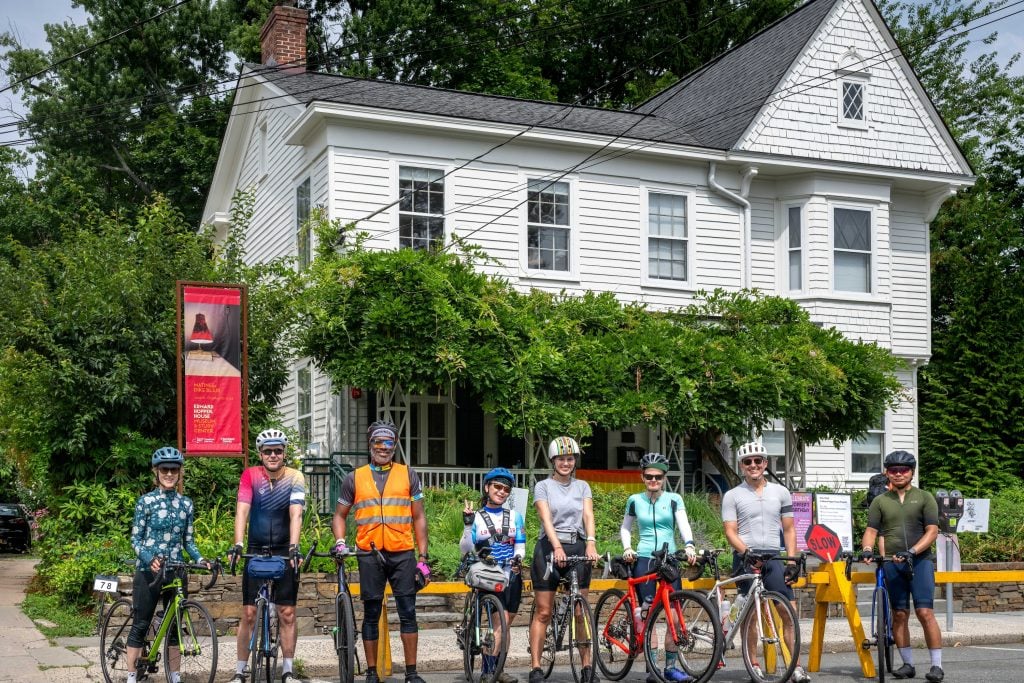
To celebrate Edward Hopper’s 142nd birthday, the Whitney Museum of American Art hosted its second annual bike ride to the artist's birthplace.

Katy Diamond Hamer

This past Saturday, July 20, the Whitney Museum of American Art partnered with Transportation Alternatives, an advocacy nonprofit focused on making streets safer for people through public transportation, bike riding, and walking, hosting a bicycle ride for what would have been Edward Hopper’s 142nd birthday. Hopper was an avid cyclist and, with his 6 foot, 7 inch frame, he liked to ride fast. Bicycles were often a subject matter of his drawings, specifically from the late 1800s when he was a resident of Nyack, New York, a town along the Hudson River. The ride is a fitting way to celebrate the famed American artist, and, after the success of the inaugural ride last year organized by Whitney curator Kim Conaty of “Edward Hopper’s New York,” the museum decided to bring it back.
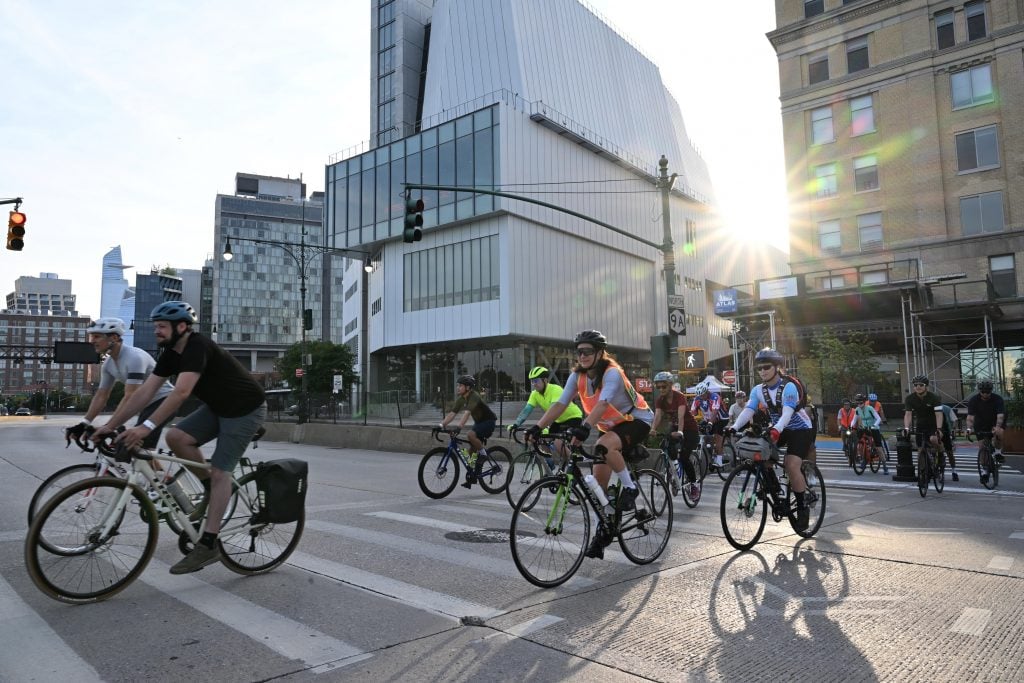
Photo by Filip Wolak. Courtesy of the Whitney Museum, 2024.
The second annual ride to Nyack, the artist’s birthplace, started at the museum in the Meatpacking District and went to the Edward Hopper House Museum & Study Center, an approximately 60-mile journey round trip. A group of around 40 riders, plus volunteer escorts from Transportation Alternatives, departed the Whitney in the early morning and rode up the Hudson Greenway to the George Washington Bridge, over the bridge, and through the rolling hills of New Jersey before winding back into New York and the picturesque town of Nyack on the edge of the Hudson River.
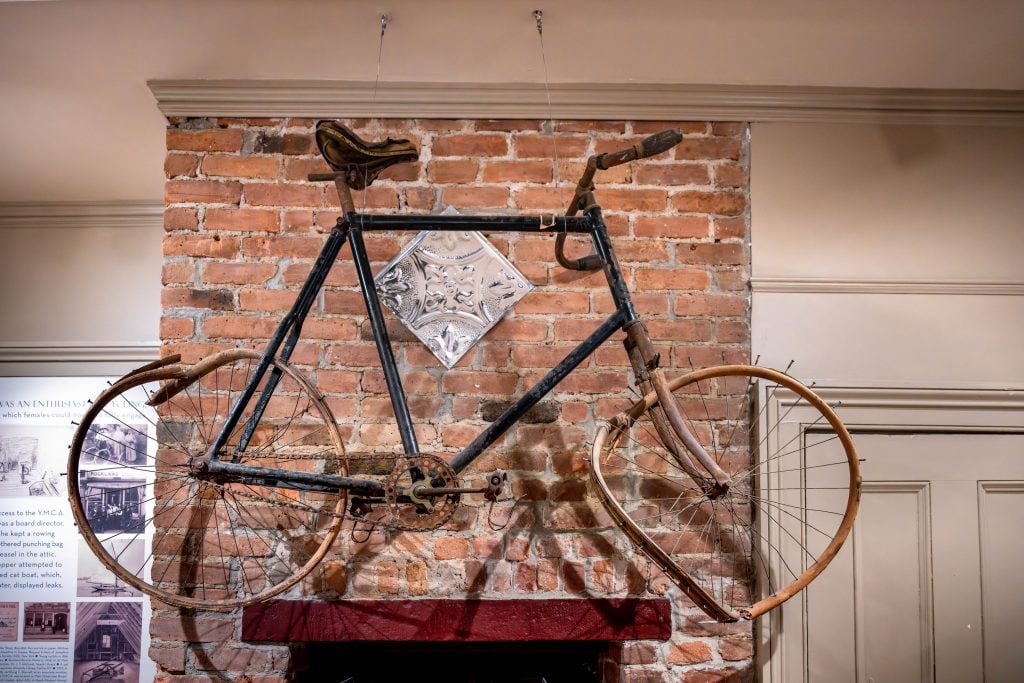
Edward Hopper’s beloved bicycle. Photograph by Andrea B. Swenson. Courtesy of the Edward Hopper House, Museum & Study Center.
Nyack has a population of 7,189 people (2022 census) and was much smaller during the artist’s formative years. The House Museum & Study Center is located in Hopper’s maternal grandmother’s home, where he spent his childhood and much of his adult life. Meeting several riders at Strictly Bicycles in Fort Lee (the first rest stop), I ventured out with a small group of four, including two leaders from Staten Island. After writing about art for over 15 years, and as a fan of Hopper, it’s surprising that I’d never been to his former home and looked forward to arriving by way of two wheels. A photographer was there to meet us at the top of a steep climb, and the museum provided snacks and fresh water for bottle refills when we arrived.
Currently, visitors can enter the Hopper House’s first and second floors, visiting the artist’s childhood bedroom and some of his early drawings, one made when he was only 9 years old! On the first floor, in a back room above a fireplace, is the artist’s bicycle, a Crescent from 1897 featuring wooden rims, and metal spokes—a fixed gear with small pegs above the front wheel to perch one’s feet.
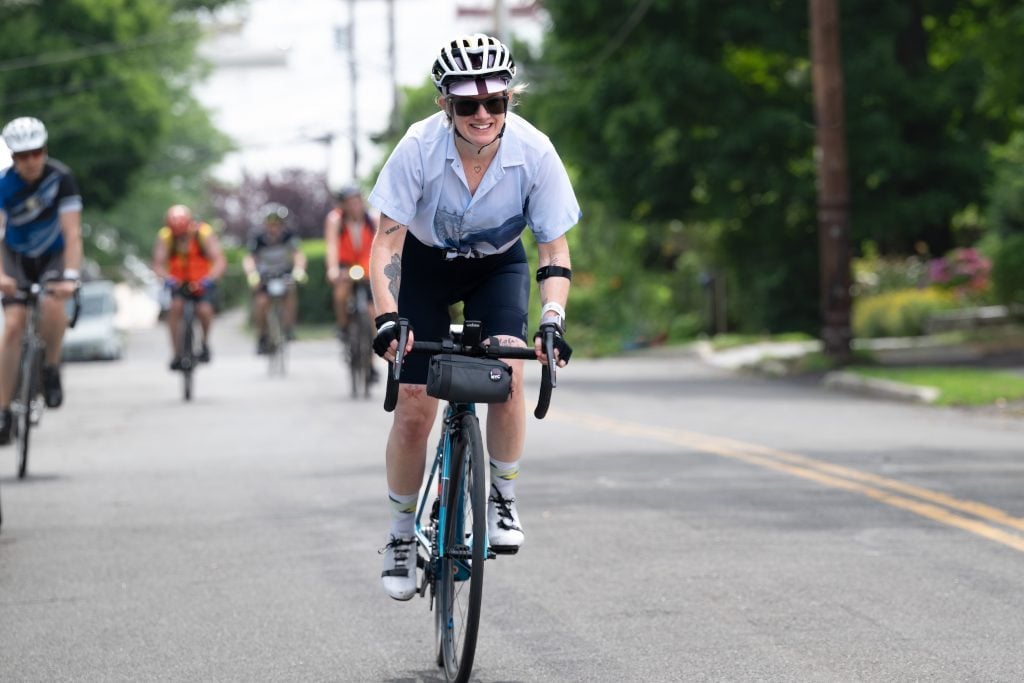
Writer Katy Diamond Hamer on the Hopper bike ride, organized by the Whitney Museum of American Art. Photograph by Andrea B. Swenson.
This wasn’t the first long-distance ride I’ve done merging my love of art and cycling. Back in July 2021, I rode with curator David Platzker on the occasion of his exhibition “Re:Bicycling” which was on view at Susan Inglett Gallery. An avid cyclist who has ridden with MoMA’s Glenn Lowry, Platzker and I cycled from the gallery in Chelsea to the Little Red Lighthouse underneath the George Washington Bridge. By the time we completed the 20 miles after talking about artists who have used bicycles in their art, such as Nina Chanel Abney and Joseph Beuys, I was ready to commit to cycling. A month later, I had an entry-level road bike and joined GirlsBikeNYC, doing my first ride to Nyack with them in the fall of 2021. By July 2022, I had a carbon race bike that tilts the scales at 15 pounds and joined the RCC (Rapha Cycling Club). So when the opportunity arose to ride with the Whitney Museum and Transportation Alternatives to the Hopper House, I jumped at the chance.
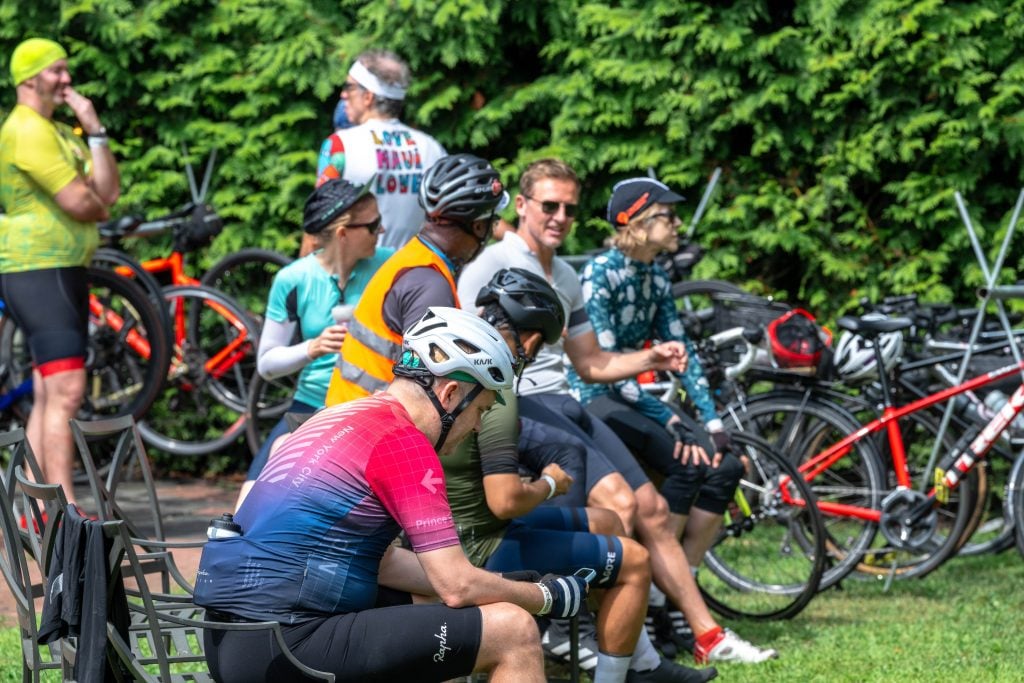
Photograph by Andrea B. Swenson. Courtesy of the Edward Hopper House, Museum & Study Center.
On this journey, I learned that for several years, the house has collaborated with artists who unexpectedly have a contemporary and aesthetic dialogue with the work of Edward Hopper. This year, curator Helen Molesworth and Karma gallery organized a show featuring landscapes and still-lifes by artist Dike Blair. The 15 paintings date from 1997 through 2022; their deliciously banal subject matters (a house exterior not with details of neon ceiling lights) fit perfectly within the quietude of Hopper’s oeuvre.
In between the sounds of cycling shoes clip-clopping on the wooden floors up and down the stairs (covered in plastic booties to protect said floors), a faint musty smell hung in the air, as docents, including Nyack historian and writer Mike Hayes, shared their knowledge about the history of the small farmhouse. Something that Edward Hopper and I have in common, besides our love of riding bikes, is that we both lived in our grandmothers’ homes until we were 26 years old. Having just learned this, I relished our other commonality of ending up living in New York City, as he relocated to Manhattan in 1908.
After hanging out in Nyack for about an hour, our small group of four started the hilly return to New York City. Having done this ride through New Jersey several times, I found myself fortunately energized with good legs (inspired by watching Tadej Pogačar win many stages of the Tour de France) and left the group after riding back over the George Washington Bridge, arriving back at the Whitney Museum, a rider of one.
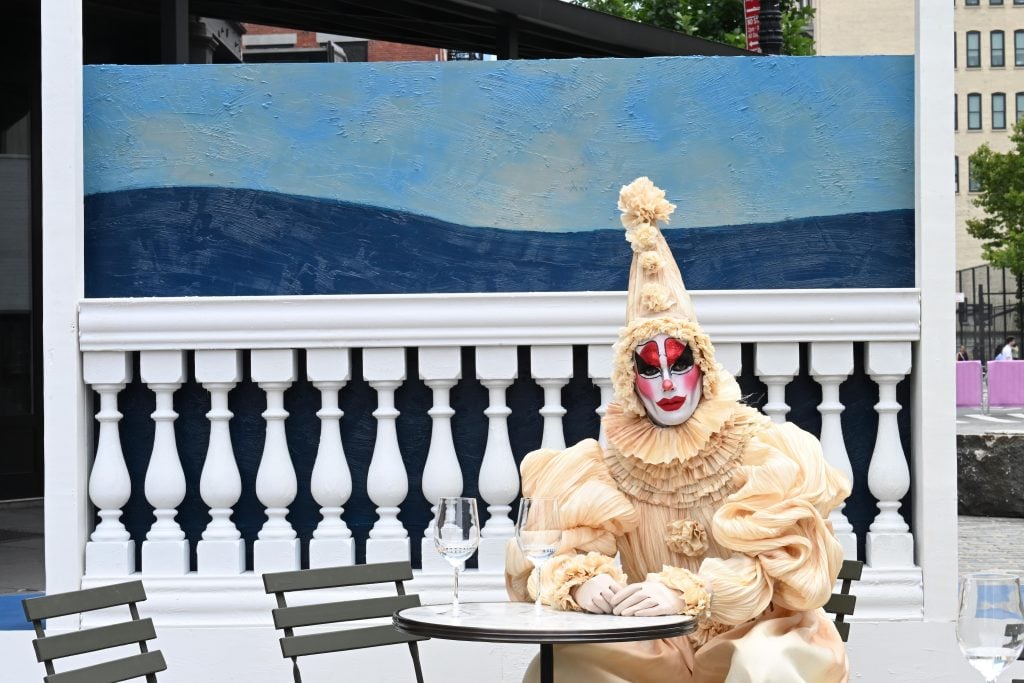
A recreation of Soir Bleu outside of the Whitney Museum of American Art. Photo by Filip Wolak. Courtesy of the Whitney Museum, 2024.
Edward Hopper started painting and drawing at such a young age and, unlike many artists, found fame within his lifetime. After his death in 1967, the Whitney Museum was bequeathed the artist’s estate, and this is where many of his paintings remain. Currently, several works by the artist are on view from the museum’s permanent collection, including Soir Bleu from 1914, this famed portrait of a downcast clown smoking a cigarette at a cafe. In addition to the ride to the Hopper House, the Whitney is celebrating Hopper’s birthday by recreating the painting as an experience the public could “step into” on Gansevoort Street near the museum. Cyclists, upon their return to the city, were invited to walk to the installation a block away and have their photo taken with a clown who seemed less depressed than the one in Hopper’s work, which of course I did. Everyone involved had smiles on their faces upon return to the museum. There is something special about cycling; the relationship between time and distance and the sense of accomplishment that comes from completing a task that might have otherwise seemed unattainable.
I’m grateful to the Whitney Museum of American Art and the Edward Hopper House & Study Center for providing the opportunity to cover the expanse between the two cities that Hopper traversed during his lifetime. In many ways, the ride helps to both solidify his artistic legacy and activate his work in a new way—Hopper’s iconic visions of American solitude and loneliness, in this way, can be engaged with through moments of community.